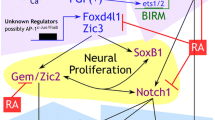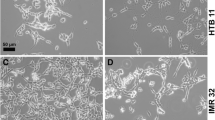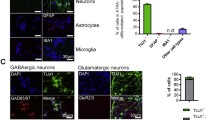Abstract
All-trans-retinoic acid (RA) plays an important physiological role in embryonic development and is teratogenic in large doses in almost all species. p53, a tumor suppressor gene encodes phosphoproteins, which regulate cellular proliferation, differentiation, and apoptosis. Temporal modulation of p53 by retinoic acid was investigated in murine embryonic stem cells during differentiation and apoptosis. Undifferentiated embryonic stem cells express a high level of p53 mRNA and protein followed by a decrease in p53 levels as differentiation proceeds. The addition of retinoic acid during 8–10 days of differentiation increased the levels of p53 mRNA and protein, accompanied by accelerated neural differentiation and apoptosis. Marked increase in apoptosis was observed at 10–20 h after retinoic acid treatment when compared with untreated controls. Retinoic acid-induced morphological differentiation resulted in predominantly neural-type cells. Maximum increase in p53 mRNA in retinoic acid-treated cells occurred on day 17, whereas maximum protein synthesis occurred on days 14–17, which coincided with increased neural differentiation and proliferation. Increased p53 levels did not induce p21 transactivation, interestingly a decrease in p21 was observed on day 17 on exposure to retinoic acid. The level of p53 declined by day 21 of differentiation. The results demonstrated that retinoic acid-mediated apoptosis preceded the changes in p53 expression, suggesting that p53 induction does not initiate retinoic acid-induced apoptosis during development. However, retinoic acid accelerated neural differentiation and increased the expression of p53 in proliferating neural cells, corroborated by decreased p21 levels, indicating the importance of cell type and stage specificity of p53 function.
Similar content being viewed by others
References
Aladjem MI, Spike BT, Rodewald LW, et al. ES cells do not activate p53-dependent stress responses and undergo p53-independent apoptosis in response to DNA damage. Curr Biol. 1998:8:145-55.
Alles AJ, Sulik KK. Retinoic-acid-induced limb-reduction defects: perturbation of zones of programmed cell death as a pathogenetic mechanism. Toxicology. 1989:40:63-171.
Almog N, Rotter V. Involvement of p53 in cell differentiation and development. Biochim Biophys Acta. 1997;1333:FI-27.
Armstrong JF, Kaufman MH, Harrison DJ, Clarke AR. High-frequency developmental abnormalities in p53-deficient mice. Curr Biol. 1995:5:931-6.
Armstrong RB, Ashenfelter KO, Eckhoff C, Levin AA, Shapiro SS. General and reproductive toxicology of retinoids. In: Sporn MB, Roberts AB, Goodman DS, eds. The retinoids. New York: Raven Press; 1984:545-73.
Atencia R, Garcia-Sanz M, Unda F, Arechaga J. Apoptosis during retinoic acid-induced differentiation of F9 embryo-nal carcinoma cells. Exp Cell Res. 1994:214:663-7.
Bain G, Kitchens D, Yao M, Huettner JE, Gottlieb DI. Embryonic stem cells express neuronal properties 171 vitro. Dev Biol. 1995:168:342-57.
Bain G, Ray WJ, Yao M, Gottlieb DI. Retinoic acid promotes neural and represses mesodermal gene expression in mouse embryonic stem cells in culture. Biochem Biophys Res Commun. 1996:223:691-4.
Chambon P. A decade of molecular biology of retinoic acid receptors. FASEB J. 1996:10:940-54.
Chen X, Ko LJ, Jayaraman L, Prives C. p53 levels, functional domains, and DNA damage determine the extent of the apoptotic response of tumor cells. Genes Dev. 1996:10: 2438-51.
Choi J, Donehower LA. p53 in embryonic development: main-taining a fine balance. Cell Mol Life Sci. 1999:55:38-47. [Review].
Davidoff AM, Pence JC, Shorter NA, Iglehart JD, Marks R. Expression of p53 in human neuroblastoma-and neuroe-pithelioma-derived cell lines. Oncogene. 1992:7:127-33.
De Luca LM. Retinoids and their receptors in differentiation, embryogenesisandneoplasia. FASEB J. 1991:5:2924-33.
Doetschman TC, Eistetter H, Katz M, Schmidt W, Kemler R. The in-vitro development of blastcyst-derived embryonic stem cell lines: formation of visceral yolk sac, blood island and myocardium. J Embryol Exp Morphol. 1985:87:27-45.
Donehower LA, Harvey M, Slagle BT, et al. Mice deficient for p53 are developmentally normal but susceptible to sponta-neous tumors. Nature. 1992:356:215-21.
el-Deiry WS, Tokino T, Velculescu VE, et al. WAFI, a potential mediator of p53 tumor suppression. Cell. 1993:75:817-25.
Evans MJ, Kaufman MH. Establishment in culture ofpluripo-tential cells from mouse embryos. Nature. 1981:292:154-6.
Ferreira A, Kosik KS. Accelerated neuronal differentiation induced by p53 suppression. J Cell Sci. 1996:109:1509-16.
Fraichard A, Chassande O, Bailbut G, Dehay C, Savatier P, Samarur J. In vitro differentiation of embryonic stem cells into glial cells and functional neurons. J Cell Sci. 1995:108: 3181-8.
Fritsche M, Haessler C, Brandner G. Induction of nuclear accumulation of the tumor-suppressor protein p53 by DNA-damaging agents. Oncogene. 1993:8:307-18.
Fulci G, Van Meir EG. p53 and the CNS: tumors and develop-mental abnormalities. MolNeurobiol. 1999:19:61-77.
Cartel AL, Tyner AL. Transcriptional regulation of the p21(WAFI/CIPI) gene. Exp Cell Res. 1999:24:280-9.
Glozak MA, Rogers MB. Specific induction ofapoptosis in P19 embryonal carcinoma cells by retinoic acid and BMP2 or BMP4. DevBiol. 1996:179:458-70.
Gottlieb TM, Oren M. p53 in growth control and neoplasia. Biochim Biophys Acta. 1996:7:77-102.
Gschwind M, Huber G. Detection of apoptotic or necrotic death in neuronal cells by morphological, biochemical, and molecular analysis. In: Poirier J, ed. Neuromethods, apop-tosis techniques and protocol. New York: Humana Press; 1997:29:13-31.
Guan K, Chang H, Rolletschek A, Wobus AM. Embryonic stem cell-derived neurogenesis. Retinoic acid induction and lineage selection of neuronal cells. Cell Tissue Res. 2001; 305:171-6. [Review].
Harper JW, Adami GR, Wei N, Keyomarsi K, Elledge SJ. The p21 Cdk-interacting protein Cipl is a potent inhibitor ofGI cyclin-dependentkinases. Cell. 1993:75:805-16.
Hayes TE, Valtz NL, McKay RD. Downregulation of CDC2 upon terminal differentiation of neurons. New Biol. 1991;3: 259-69.
Joiakim AP, Chopra DP. Retinoic acid and calcium regulation of p53, transforming growth factor-beta I, and transform-ing growth factor-alpha gene expression and growth in adenovirus 12-SV40-transformed human tracheal gland epithelial cells. Cell Mol Biol. 1993:8:408-16.
Kastan MB, Onyekwere O, Sidransky D, Vogelstein B, Craig RW. Participation of p53 protein in the cellular response to DNA damage. Cancer Res. 1991:51:6304-11.
Kastan MB, Zhan Q, el-Diery WS, et al. A mammalian cell cycle checkpoint pathway utilizing p53 and GADD45 is defective in ataxia-telangiectasia. Cell. 1992:71:587-97.
Keller GM. In vitro differentiation of embryonic stem cells. Curr Opin Cell Biol. 1995:7:862-9.
Ko LJ, Prives C. p53: puzzle and paradigm. Genes Dev. 1996; 10:1054-72.
Kochhar DM. Assessment of teratogenic response in cultured postimplantation mouse embryo. In: Neubert D, Merker HJ, eds. New approaches to evaluation of abnormal em-brayonic developement effects of hydrosyurea. Action, MA: Thieme-Edition Publishing Science Group. 1975:250-77.
Leahy A, Xoing J, Kuhnert F, Stuhmann H. Use of developemental marker genes to define temporal and spatial patterns of differentation during embryoid formation. J Exp Zool. 1999;284:77-81.
Lotan R. Effects of vitamin A and its analog (retiniods) on normal and neoplastic cells. Boichim Biophys Acta. 1980;605:33-91.
Lutzker SG, Levine AJ, A funtionally inactive p53 protein in teratocarcinoma cells is activated by either DNA damage or cellular differentation. Nat Med. 1996;2;804–10.
Napoli JL. Biochemical pathways of retinoid transport, metabolism and metal transduction. Clin Immunol Immunol-pathtol. 1996;80:S52-62.
Nelson WG. Kastan MB. DNA strand breaks: the DNA template alterations that trigger p53-dependent DNA response pathway. Mol Cell Biol. 1994;14:1816-23.
Okazawa H, Shimizu J, Kamei M, Imafuku I, Hamada H, Kanazawa I, Bcl-2 inhibits retonic acid-induced apoptosis during the neutral differentiation of embrayonal stem cells. J Cell Biol. 1996;132:955-68.
Oren M, Reich NC, Levine AJ, Regulation of the cellurar p53 tumor antigen in teratocarcinoma cells anfd their differentiated progeny. Mol Cell Biol. 1982;2:443-9.
Parker SB, Eichele G, Zhang P, et al. p53-independent expression of p21Cip1 in muscle and other terminally differentiating cells. Science. 1995;267:1024-7.
Raff MC. Sociloa controls on cell survival and cell death. Nature. 1992;356:397-400.
Ronca F, Yee KS. Yu VC. Retonic acid confers resistance to p53-dependent apoptosis in SH-SY5Y neuroblastoma cells by modulating nuclear import of p53. J Biol Chem. 1999;274:128-34.
Sabapathy K, Klemm M, Jaenisch R, Wagner EF, Regulation of ES cell Differentiation by functional and comformational modulation of p53. EMBO J. 1997;16:6217-29.
Sah VP, Attardi LD, Mulligan GJ, Williams BO, Bronson RT, Jacks TA. Subset of p53-deficient embryos exhibit exencephaly. Nat Genet. 1995;10:175-80.
Schmidt-Kastner PK, Jardine K, Cormier M, McBurney MW. Absence of p53-dependent cell cylcle regulation in pluripotent mouse cell lines. Oncogene. 1998;16:3003-11.
Scott MP. Tamkun JW. Hartzell GW. The structure and function of the homeodomain. Biochim Biophys Acta. 1989;28:25-48.
Smith AG, Health JK, Donalson DD, et al. Inhibition of Pluripotential embryonic stem cell differentiation by purified polypeptides. Nature. 1988;336:688-90.
Sturbing C, Ahnert-Hilger G, Shan J, Wiedenmann B, Hescheler J, Wobus AM. Differentiation of pluripotent embryonic stem cells into the neuronal lineage in vitro give rise to mature inhibitory and excitatory neurons. Mech Dev. 1995;53:275-87.
Uren AG, Vuax DL, Molecular and clinical aspects of apoptosis. Pharmacol Ther. 1996;72:37-50.
van Inzen WG. Peppelenbosch M, van den Brand MW, Tertoolen LG, de Laast SW. Neuronal differentiation of embryonic stem cells. Biochim Biophys Acta. 1996;1312:21-6.
van Lookeren Campagne M, Gill R. Tumor-suppressor p53 is expressed in proliferating and newly formed neurons of the embryonic ang postnatal rat brain: comparison with expression of the cell cycle regulators p21Waf1/Cip1, p27Kip1, p27Kip2, p16Ink4a, cyclin G1, and the proto-oncogene Bax. J Comp Neurol. 1998;397:181-98.
Wali A, Strayer DS. Regulation of p53 gene expression by a poxviral transcription factor. Virologty. 1996;224:63-72.
Yonish-Rouach E. The p53 tumour suppressor gene: a mediator of a G1 growth arrest and of apoptosis. Experientia. 1996;52: 1001-7.
Yonish-Rouach E, Resnitzky D, Lotem J, Sachs L, Kimchi A, Oren M. Wild type p53 induces apoptosis of myeloid leukaemic cells that is inhibited by interleukin-6. Nature. 1991;352:345-7.
Author information
Authors and Affiliations
Rights and permissions
About this article
Cite this article
Sarkar, S., Sharma, R. All-trans-retinoic acid-mediated modulation of p53 during neural differentiation in murine embryonic stem cells. Cell Biol Toxicol 18, 243–257 (2002). https://doi.org/10.1023/A:1016003027850
Issue Date:
DOI: https://doi.org/10.1023/A:1016003027850




